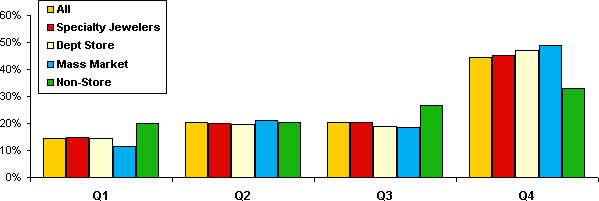'Tis The Season For Gold
October 07, 07
By Ken Gassman
Tradition says that three wise men brought gifts of gold, frankincense and myrrh to mark the birth of a prophet in Bethlehem more than two thousand years ago. That tradition continues in the U.S. market, at least for gold, each year during the holiday season, which marks the anniversary of this event. American consumers buy disproportionately more gold jewelry in the fourth quarter – especially at Christmas – than at any other time of the year.
Graph 1 Source: World Gold Council
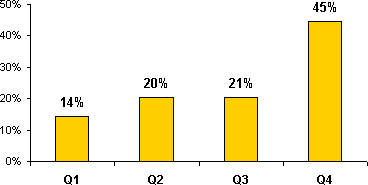
Graph 1 illustrates that 45 percent of all gold jewelry (by value) is sold in the fourth calendar quarter.
Conversely, even though the Valentine’s selling period occurs in the first quarter, gold jewelry is not a major purchase for that consumer event. It is interesting that gold jewelry sells well in the third quarter, a period with no major jewelry sales event. First quarter jewelry demand is fueled by Valentine’s; second quarter jewelry demand is fueled by Mother’s Day; and fourth quarter jewelry demand is fueled by the holiday gift-giving period, which includes Christmas, Chanukah and Kwanzaa.
Seasonality of Gold Jewelry Demand Has Increased
Over the past decade and a half, gold jewelry sales have become more seasonal, a trend illustrated on graph 2.
Graph 2 Source: World Gold Council
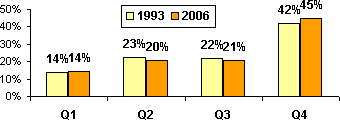
Interestingly, gold jewelry has become a more important purchase during the all-important holiday season, but a less important purchase especially in the second quarter Mother’s Day period. Apparently, mom is now getting pearls or chocolates, rather than gold jewelry.
Gold Jewelry Reflects More Seasonality than Other Jewelry Categories
Demand for gold jewelry is much more seasonal than demand for “all jewelry.” As graph 3 illustrates, gold jewelry is particularly popular in the all-important fourth quarter Holiday Season as a gift under the tree. About 45 percent of all gold jewelry is purchased in the fourth quarter, far ahead of the 38 percent of “all jewelry” that is purchased in the same three-month period.
Graph 3 Source: World Gold Council
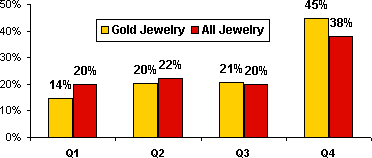
Seasonality by Retail Distribution Channel Varies
While gold jewelry demand correlates closely for specialty jewelers and department stores, there is some seasonal variation from the norm among mass market retailers and non-store merchants. In particular, demand for gold jewelry from non-store merchants is much less seasonal than for gold jewelry purchased through other retail channels. We believe this helps confirm the notion that gold jewelry is an impulse purchase: when shoppers see something they like, they want to own it immediately, rather than waiting several days for a shipment to arrive at their front door. Despite this theory, most television shopping outlets claim that gold jewelry sales are strong.
| Graph 4
Source: World Gold Council |
Mass merchants’ gold sales (blue bar on graph 4) are abnormally strong in the fourth quarter as bargain-hunting shoppers search for holiday gifts. This trend tends to confirm our thesis that gold jewelry may be moving downscale.
Gold Jewelry Categories Reflect Similar Seasonal Demand
Some jewelers tell us that their sales of gold wedding bands ramp up sharply in the spring, prior to summer weddings. That may be so, but statistics from the World Gold Council suggest that demand for wedding bands – and all other gold jewelry categories – reflect approximately the same seasonality. In short, no gold jewelry category stands out with an abnormal seasonal demand pattern.
Graph 5 summarizes seasonality by gold jewelry category.
Graph 5 Source: World Gold Council
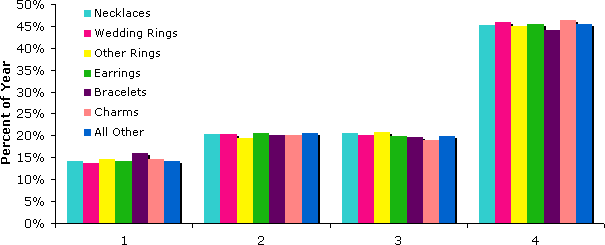
Average Ticket Undulates by Quarter
The largest average ticket for gold jewelry is generated in the third calendar quarter of the year. As a reminder, that’s the quarter with no major sales event driving jewelry demand.
Earlier, we noted that Mother’s Day was declining as an important sales event for gold jewelry. In addition, those mothers who are receiving gold jewelry may not know it, but the amount spent on their gold jewelry is below the annual average, as graph 6 illustrates.
Graph 6 Source: World Gold Council
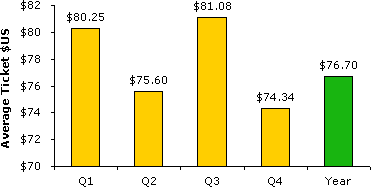
The average ticket for Valentine’s gold jewelry remains strong. As expected, the average ticket for gold jewelry is lower in the fourth quarter, because there is a lot of gift-giving at the $49-$69 price points for low-karat gold jewelry.
We speculate that the average ticket for gold jewelry is high in the third quarter because there is much self-purchase activity, and we only want the best for ourselves.
